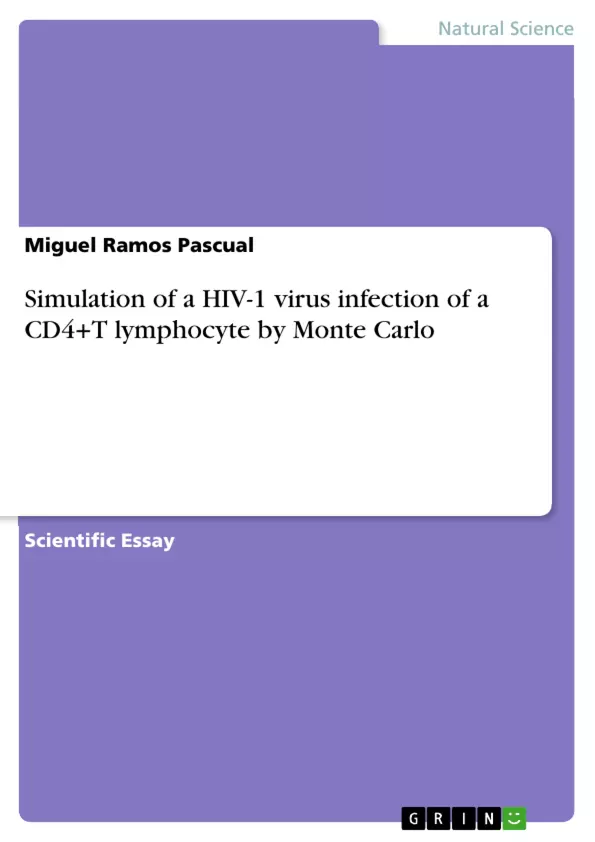The Human Inmunodeficiency Virus (HIV) is a retrovirus which preferentially infects CD4+T lymphocytes of the human immune system during its replication cycle. Although the cycle is similar to other retroviruses, there are still aspects which remain unknown, so further research is still needed. Computerised biology brings the possibility to reproduce with low resources the virus replication cycle, focusing on those steps in which real laboratory conditions are difficult to achieve. The software HIV.pro has been developed to simulate by Monte Carlo methods the replication cycle of HIV-1 virus, providing estimators of HIV protein concentrations in the nucleous and cytoplasm, spliced and unspliced mrna concentrations, viral burst size, time and number of transcriptions for first virus release. HIV-1.pro software simulates acuratelly the intracelullar process of virus infection, providing reliable results of virus infectivity.
Inhaltsverzeichnis (Table of Contents)
- Introduction
- HIV-1 virus
- Introduction
- HIV-1 virus cycle
- Software HIV.pro
- Introduction
- Module Transcription
- Modules Splicing and Export
- Module Translation
- Module RNA Packaging
- Module Assembly
- Simulation by Monte Carlo
- Results and discussion
Zielsetzung und Themenschwerpunkte (Objectives and Key Themes)
This technical report presents the development and application of a software called HIV.pro, which simulates the replication cycle of the HIV-1 virus in a CD4+T lymphocyte using Monte Carlo methods. The software aims to provide accurate estimates of various parameters related to HIV-1 infectivity, such as protein concentrations, viral burst size, and time for first virus release. The software has been successfully used to simulate the infection of a CD4+T lymphocyte with a single HIV-1 virus, providing valuable insights into the intracellular processes of viral infection.
- Modeling the HIV-1 replication cycle in a CD4+T lymphocyte
- Estimating HIV protein concentrations, viral burst size, and time for first virus release
- Investigating the role of regulatory proteins (Tat and Rev) in transcription and export of viral RNA
- Analyzing the kinetics of virus assembly and packaging
- Assessing the accuracy and reliability of the Monte Carlo simulation model
Zusammenfassung der Kapitel (Chapter Summaries)
- Introduction: Introduces the Human Immunodeficiency Virus (HIV) as a retrovirus that preferentially infects CD4+T lymphocytes, causing a decline in the immune system and leading to AIDS. Discusses the need for further research and the potential of computerised biology to model the virus replication cycle.
- HIV-1 virus: Provides a detailed overview of the HIV-1 virus, including its genome, structural proteins, enzymes, and regulatory proteins. Describes the HIV-1 replication cycle, highlighting key steps such as attachment, fusion, reverse transcription, integration, transcription, splicing, export, translation, assembly, and budding.
- Software HIV.pro: Introduces the software HIV.pro, a Fortran 90/C++ code designed to simulate the HIV-1 replication cycle in an intracellular scale. Explains the software modules responsible for simulating transcription, splicing, export, translation, RNA packaging, and assembly of new virions. Details the simulation parameters and probabilities used.
- Simulation by Monte Carlo: Explains the use of Monte Carlo methods for simulating the infection of a CD4+T lymphocyte with a single HIV-1 virus. Describes the simulation parameters, probabilities, and the method used for estimating variables.
- Results and discussion: Presents the results of the Monte Carlo simulations, including the estimated number of mrnas produced by RNAPII transcription, protein concentrations in the nucleus and cytoplasm, viral burst size, time for first virus release, and the fraction of viruses containing vif protein. Discusses the significance of these findings and the implications for understanding the HIV-1 replication cycle.
Schlüsselwörter (Keywords)
HIV-1, virology, virus cycle, Monte Carlo, CD4+T lymphocytes, protein concentrations, viral burst size, time for first virus release, transcription, splicing, export, translation, RNA packaging, assembly, budding.
- Citar trabajo
- Miguel Ramos Pascual (Autor), 2019, Simulation of a HIV-1 virus infection of a CD4+T lymphocyte by Monte Carlo, Múnich, GRIN Verlag, https://www.grin.com/document/505210



